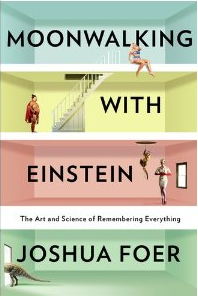What are you more likely to remember: The gray car you passed on your way to work or the car parked on the side of the road with a mural painted on the hood and doors? Obviously the vibrant car will stick in your memory because it is different and interesting.
This is exactly what journalist
Joshua Foer discovered when he dove into the world of the human memory. In his book, titled,
Moonwalking With Einstein: The Art and Science of Remembering Everything, Foer gives us strategies to use to make us remember everything:
(Excerpt from
7 Tricks to Improve Your Memory:)
Use graphic images to remember: Your brain is wired to remember visually and spatially, and the more erotic and exotic the images, the better your brain does. Foer writes that you have to “take the kinds of memories our brains aren’t good at holding on to and transform them into the kinds of memories our brains were built for.” It’s called elaborate encoding: “The general idea with most memory techniques is to change whatever boring thing is being inputted into your memory into something that is so colorful, so exciting, and so different from anything you’ve seen before that you can’t possibly forget it,” he writes in his book.
Associate hard-to-remember facts with your childhood home. In order to remember a to-do list, or even names of people, you need to place these things in something very familiar like the house you grew up in. Take a visual tour of your house starting with the front door, placing your first item on your list there, and wend your way through your house placing each item in different hallways or rooms. But don’t just place “call Sophia,” on the front stoop. Take the image to the extreme. Think of what Sophia reminds you of (Sophia Loren) and visually place her sitting on the lap of a she-male making a phone call (this is Foer’s example, not mine). Or, suggests Foer, if you’re trying to remember to buy cottage cheese, think of Claudia Schiffer swimming in a giant vat of it. After you’ve place down your memories, then retake that tour of your house and you’ll visually pick up and remember each of the items you laid down.
Oh yeah, make the images very erotic–and absurd, according to 29-year-old Foer, and the centuries of mental athletes (mostly male) that came before him. That’s pretty much how our minds are wired, so go with it. You’re bound to remember absurdly lurid images more than you’d remember the mundane.
Connect the image to a celebrity or close relative or friend.Go back to that Sophia Loren example. When you meet someone, quickly think of an association–an actor, a model, the president, your grandmother–and think of that person in an outrageous situation, the more lurid the better.
Use “chunking” to remember passwords. Chunking–grouping numbers or letters into chunks–helps make it easier for a long sequence to be remembered. This is why credit card numbers are separated into groups of four and hyphens are inserted into phone numbers. Thus, the password Li34TH7 can be chunked as Li 34 Th7. And your memory will work even better if you put the chunks into a context. Long Island (Li), 34th street (34TH) and 7th avenue (7).
Code your numbers. To remember numbers, use an age-old technique called “Major System.” It uses a code to change numbers into letters and then those letters can form easy-to-remember words, which can then be visualized. You’ll have to read his book, p. 164 to get the code, but wrote Foer, “When I first learned it, I immediately memorized my credit card and bank account numbers.”
Practice, practice, practice. Visualizing images, and doing it in a matter of seconds, takes practice. Your mental muscles get better at it the more you do it. One of the memory experts Foer interviewed told him that if he practiced one hour a day, six days a week, he could be in the top 3 of the U.S. Memory Championship. Which he did!


No comments:
Post a Comment